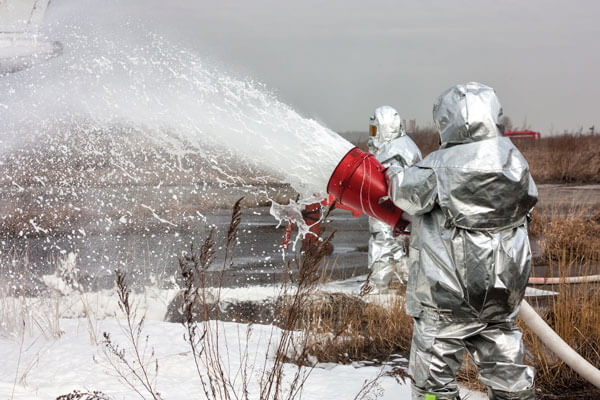
Foam concentrate, used for mixing with water to generate foam solution has come under recent scrutiny. According
to a newsletter, published by the trade association Fire Fighting Foam Coalition (FFFC), there are now federal and
state laws that
restrict the sale and use of aqueous filmforming foam (AFFF)1. Any foam that includes the chemicals
known by their acronym PFAS (per and polyfluoroalkyl) is being targeted. That is because when PFAS is released
into the environment,
it eventually gets into lakes and streams and affects our water supply. It then can accumulate in the blood of
humans and animals. These chemicals are known to contribute to adverse health outcomes, including thyroid disease,
liver damage,
and kidney cancer.
The FFFC newsletter (June, 2021) identified 19 states with new laws regarding PFAS. Additionally, the US Navy
plans new restrictions on the use of AFFF, and the Federal Aviation Administration (FAA) plans to make changes to
their allowance of
the use of AFFF at airports for aircraft rescue and fire fighting (ARFF) purposes.
In January, 2020, the NFPA Fire Protection Research Foundation published a report on their findings of fire
testing of replacements for the foams containing PFAS2. That research was reviewed by the NFPA
Technical Committee on Foam,
and information is now contained in the 2021 edition of NFPA 11,
Standard for Low-, Medium-, and High-
Expansion Foam3. The information on Synthetic Fluorine- Free Foam (SFFF) Research Testing is
provided in Annex H of NFPA 11.
As noted in Annex H of NFPA 11, “…FFFs (fluorine-free foams) have come a long way, there is more to learn about
their capabilities and limitations. As of today, FFFs are not a drop-in replacement for AFFFs. However, some can
be made to perform
effectively as an AFFF alternative with proper testing and design (i.e., with higher application rates and
densities).” The annex goes on to say “The FFFs typically required between 1.5 to 3 times the application rates to
produce comparable
performance as the baseline AR-AFFF for the range of parameters included in this assessment.”
As a note of caution, NFPA has determined that the alternative foams, called FFFs, are not drop-in replacements
for AFFF. Additional testing and analysis is needed to determine effectiveness, application rates, and other
parameters before they
can be used in systems and portable fire extinguishers. Also, the manufacturers’ Safety Data Sheets (SDS) provide
clear information on use of these products (one manufacturer SDS states the FFF can be used for training purposes
only).
Although there is much information on the health impact of fluorinated foams, including AFFF, the jury is still
out on the replacement FFFs. End users should be made aware of this information before they make any decisions
related to using FFFs.
Also, since there are health concerns related to the release of any products containing PFAS, they should be
cautious not to inadvertently release AFFF into the environment and to report any use of AFFF to local, state, and
federal environmental
agencies.
Along with keeping close communication with federal entities, states, and localities, the US Environmental Agency
(US EPA) provides updates on their webpage as the issue evolves
4. Any FED, end user, or other stakeholder that has questions regarding this issue should contact the
US EPA5.
1Fire Fighting Foam Coalition (FFFC) newsletter “AFFF Update”, June 2021, https://www.fffc.org/#:~:text=Over%20the%20last%20two%20
years,are%20key%20ingredients%20in%20AFFF
2Evaluation of the Fire Protection of Flourine Free Firefighting Foams, January
2020, https://www.nfpa.org/-/media/Files/News-and-Research/
Fire-statistics-and-reports/Suppression/Appendix-Comparative-
Characterization-of-Gasoline-Samples.ashx
3NFPA 11, Standard for Low-, Medium-, and High-Expansion Foam, 2021 Edition, https://www.nfpa.org/codes-and-standards/all-codes-andstandards/
list-of-codes-and-standards/detail?code=11
4Per- and Polyfluoroalkyl Substances (PFAS), https://www.epa.gov/pfas
5Contact US EPA about PFOA, PFOS and other PFAS, https://www.epa.
gov/pfas/forms/contact-us-about-pfoa-pfos-and-other-pfas